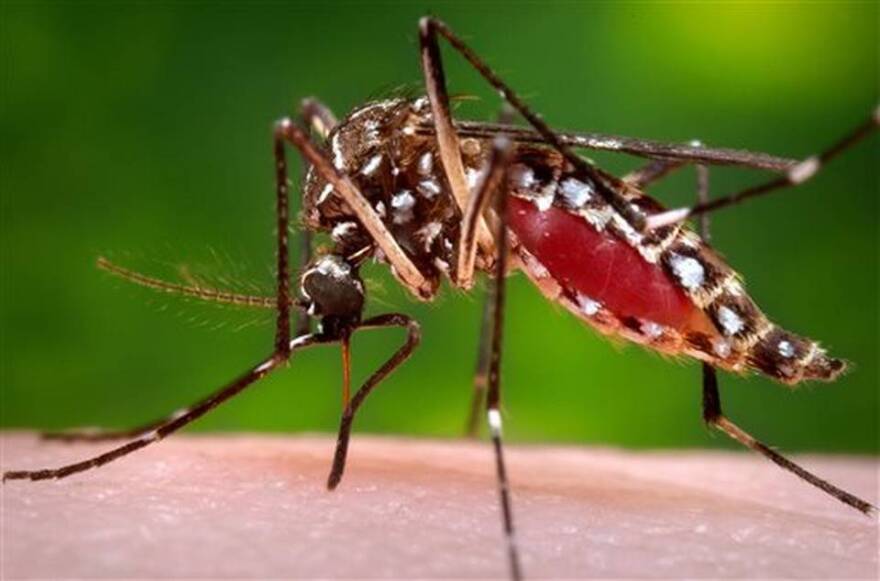Lab-bred mosquitoes are flying in South Miami. It’s the latest effort to stop the type of mosquito that spreads the Zika virus.
These are the same type of mosquitoes used in a trial last year in the Lower Keys.
But this experiment will contain a lot more mosquitoes, nearly 666 million. The male mosquitoes are infected with the Wolbachia bacteria, and when they mate with female Aedes aegypti, which can carry Zika, the females do not have offspring.
In 2016, there were more than 1,300 reported cases of Zika across the state.
On The Florida Roundup, WLRN’s Tom Hudson got the scoop on the skeeters with South Miami Mayor Philip Stoddard; William Petrie, director of the Miami-Dade Mosquito Control Division, and Andrea Leal, executive director of the Florida Keys Mosquito Control District.
@PKStoddard says this is the safest mosquito control experiment they could have done. These are mosquitoes that can carry #Zika and yellow fever
— WLRN Public Media (@WLRN) February 2, 2018
WLRN: Are they out now in the environment?
STODDARD: They're starting the releases. There's a few things people need to know. While these are originally bred in the lab, these are not genetically modified. They're infected with a natural bacterium Wolbachia pipientis, which is found in mosquitoes around the world but not our local mosquitoes. If it's in the male but not in the female, the offspring don't develop.
So, what they're releasing is male mosquitoes that do not bite. Male mosquitoes drink nectar from flowers, so they're completely benign. You'll probably never even see them.
WLRN: So how many of these will be released? What's the timeframe of this test? What kind of locations are they going to be released in?
STODDARD: They're going to release approximately two-thirds of a billion male mosquitoes. The way this works is you have to release a lot more of these males than existing natural males because you want these mosquitoes to be the ones to find the females, not the natural male. So you really have to swap out the natural male population and make it hard for our local male mosquitoes to get a date.
WLRN: So that number of mosquitoes is released over what time period?
STODDARD: They're starting now with a few and they're going to ramp up and get heavier, I expect, through the rainy season, so this will extend out well into the summertime.
WLRN: Dr. Petrie, you come to us from the Cayman Islands. Welcome to South Florida. How many months will this experiment last in South Miami?
PETRIE: It will run until at least the end of July and possibly be extended past that, so we can get a proper evaluation of the operation.
WLRN: What kind of locations will these mosquitoes be released in?
PETRIE: We've chosen two locations which are very similar and identical in size and very similar in their make-up residencies. And the idea there is that we will be able to compare one area that will be treated and one area untreated. Essentially, we'll be able to compare those two areas to see just how successful the technique is working.
WLRN: Because the science works by essentially killing off the next generation and doesn't allow them to hatch, at what point will you be able to deem this experiment a success or a failure?
PETRIE: It will all depend on the data coming in. We will have a number of mosquito traps around the areas, quite densely populated. So we will be able to monitor the populations through the whole scope of the project.
WLRN: South Miami has kind of an urban downtown area and then has mostly single-family residences. In what kinds of areas are these mosquitoes going to be released?
PETRIE: That's exactly the type this mosquito breeds in.
WLRN: But will it be in the downtown core around U.S. 1 or is it out in the neighborhoods?
STODDARD: It's in a single-family neighborhood, an area we call the Twin Lakes neighborhood.
WLRN: This is not the first time these kinds of mosquitoes have been used in South Florida as an experiment to try to control the species of mosquito that carries the Zika virus among other diseases.
In the Lower Keys, an experiment began last summer. Andrea, what can you tell us about the experiment in the Lower Keys from last summer?
LEAL: First, I want to just make sure everybody understands last summer's trial in the Lower Keys wasn't really inefficient to trial. We weren't really trying to see if we could reduce population. It was more, 'Will this work?' What is the best method to ship these mosquitoes down from Kentucky?' And our trial area was very small - about 10 acres. So we did learn a lot. We learned that the shipments worked just fine. We realized about halfway through that we needed to release more mosquitoes than what we are releasing. By the end of the summer we released just under 1.3 million mosquitoes in this area.
WLRN: What is applicable from the experiment that you described in the Lower Keys to what will be going on over the next couple of months in South Miami?
LEAL: One of the best things that we found last year during the experiments in the Lower Keys was how far these mosquitoes do travel. When we originally started, we were going to try to do some comparative areas, but what we found is that the areas we chose were too close together. We were seeing a lot of mosquito movement. We learned how far they can fly, where are they going and about how many to release per week in our environment.


